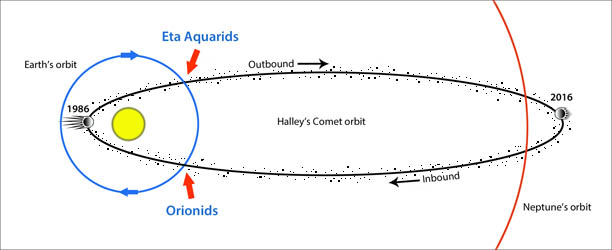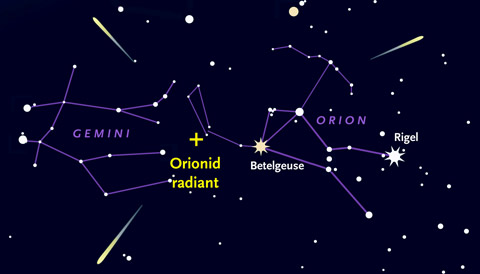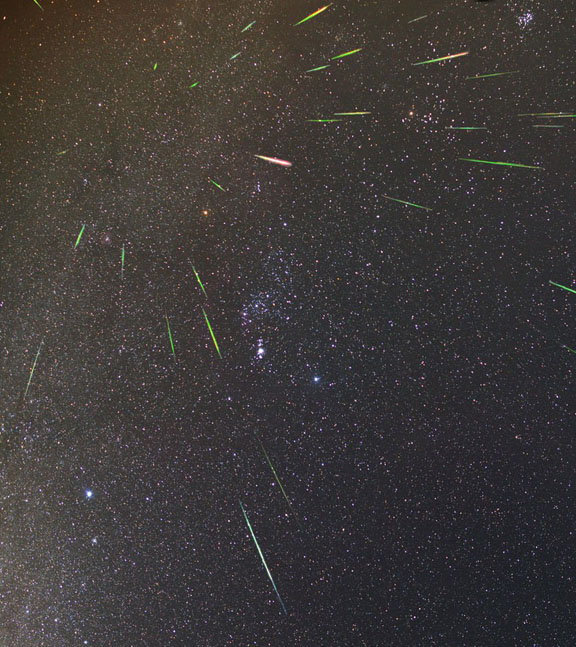Astronomy - Halley On Fire! Orionids Peak This Week
The annual Orionid meteor shower is active all week, peaking Friday morning October 21st. If you're up before dawn, you might just see these Halley's Comet castoffs come to life.

A bright Orionid makes a dash near the star Bellatrix in northern Orion during the 2014 shower.
Bob King
Bob King
Christmas may come only once a year, but dust fromHalley's Comet fires up the night sky twice: first in May during the Eta Aquarid meteor shower and this week when the Orionid shower peaks on the mornings of October 20th and 21st.
Meteor showers beautifully illustrate the more-bang-for-your-buck concept. A one-gram fragment of Halley slamming into Earth's atmosphere at a typical speed of around 148,000 mph (238,000 km/h) can produce a jaw-dropping fireball.
Nature ensures that even tiny rocks possess surprising power as long as they're moving fast. This energy of motion or kinetic energy is transferred to the atoms and molecules in the particle's path, briefly ionizing them. When the atoms return to their rest states, they emit light in the form of a meteor, or as my daughters would put it: "Look, Daddy, a shooting star!"
Many shower meteoroids range in size from 1 mm to 1 cm (1/2 inch), and since most originate from comets, the material isn't rock solid but fluffy and friable. Perhaps you've witnessed a meteor that splits or break into pieces as it streaks through the air. When fragile bits strike the atmosphere at such high speeds, they might as well be hitting a brick wall. Pieces go flying.

Orionids hail from Halley's Comet. When Earth encounters the inbound leg of the comet's orbit, we plow through the comet's dust trail. Motes, particles, and tiny pebbles strike the atmosphere at high speed, flare, and create a shower of meteors. Perturbations by planets and the Sun have caused the particles to spread out into a ribbon centered on Halley's orbit. Halley's position is shown at perihelion in 1986 and in the current year, 2016. Not to scale.
Bob King
Bob King
In May, the Earth crosses the outbound leg of Halley's orbit, and in October, the inbound leg. Halley returns to the Sun's vicinity every 76 years, gets roasted by sunlight, and makes a fresh deposit of motes, granules and fragments along its path, ensuring a supply of meteoroids for generations to come.
I love the ease of meteor watching. While it's important to be as comfortable as possible whenever you're out under the night sky, meteor showers provide an opportunity to spoil yourself with a few creature comforts. How about a nice reclining chair to pamper the back and a sleeping bag to stay cozy and warm? While you're at it, a mug of hot tea or coffee would fit right in along with a pair of earbuds and your favorite music. Or listen instead to the late leaves clattering in the breeze before November sets them free.

Orionid meteors, created by bits of debris from Halley's Comet, appear to radiate from a point near the upraised club or Orion. The shower is active through October 25th but reaches maximum on the 21st.
Sky & Telescope illustration
Sky & Telescope illustration
I normally make a mental tally of how many meteors I see and keep a camera by my side equipped with anintervalometer to maximize my chances of catching a meteor without having to attend to the shutter button. If you'd prefer a more rigorous approach, there's room for that, too. The American Meteor Society conducts a Visual Observing Program to keep track of changing activity in traditional showers as well as assist in the discovery of new ones. Use this basic form to record your meteor sightings.

Amateur astronomer Phil Hart of Australia composited a fine display of Orionids in 2011 into this stunning single image. All Orionid meteors, no matter where they appear in the sky, will point back to the radiant in northern Orion.
Phil Hart
Phil Hart
Where and When to Look
The Orionids start twitching as early as the first week in October but don't peak until Friday morning October 21st. Under a dark, moonless sky you'd typically catch about 20 meteors an hour radiating from the club of Orion high in the southern sky, but this year that number will be halved by the last-quarter Moon.
Don't let that stop you from taking time out this coming week to give Halley its due. Orionids are among the fastest of shower meteors; even if a few flash by, you'll be impressed by their swiftness. They normally peak when the radiant is highest, about an hour or two before the start of dawn (3:30–5:30 a.m.).
Make sure to face east or southwest, so you're not looking directly at the Moon. To do so would compromise your night vision and reduce the shower's visibility further. Then just settle in and watch the parade of winter stars overhead get peppered with pieces of Halley. If the sky is cloudy or you simply can't afford to lose the sleep, SLOOH will live broadcast the shower online starting at 8 p.m. EDT October 20th.
This year's relative dearth of meteors will help us better appreciate the 2017 show, when no Moon will trouble the sky. Good luck, and please stop back to share your observations!
No comments:
Post a Comment